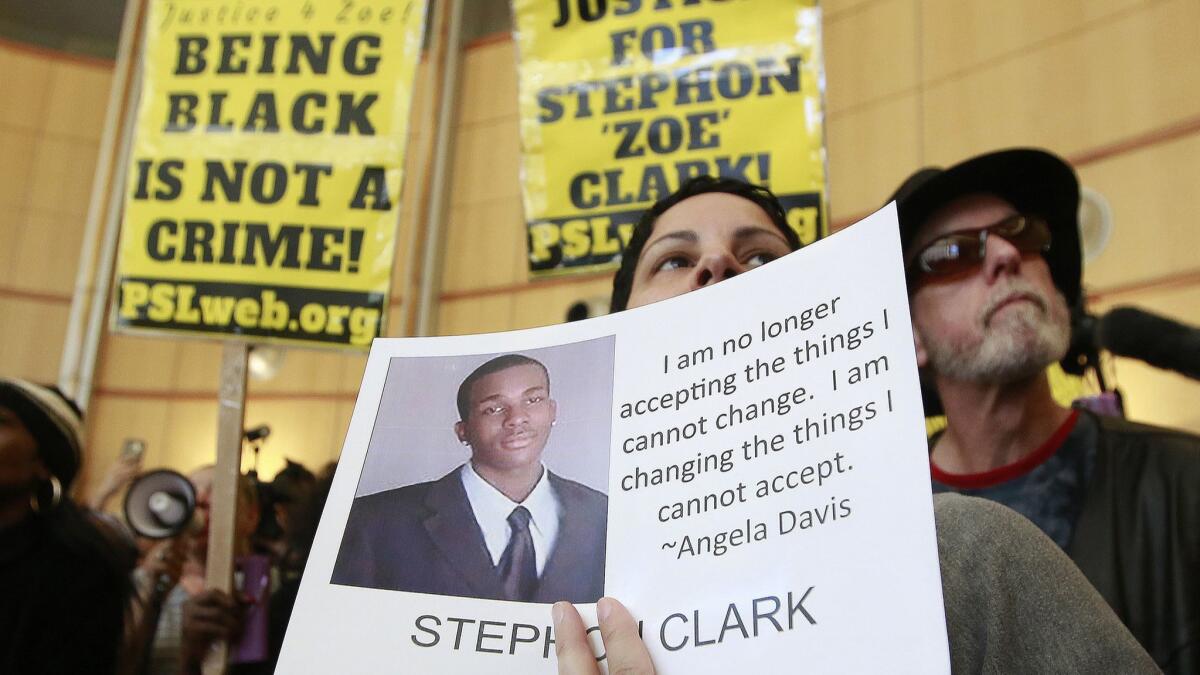Deadly encounters involving police use of force decline in California, report finds

- Share via
Reporting from Sacramento — A new report spurred by national concern over fatal shootings by police shows 146 civilians and three officers died during law enforcement confrontations in California last year, with fewer violent encounters and deaths of suspects than in previous years.
It was one of five reports released by the state attorney general’s office on Tuesday showing that California also saw fewer property crimes, hate crimes and homicides and other violent crimes, even after voters and lawmakers significantly eased criminal penalties in recent years.
The 146 civilians who died in police confrontations was down from 172 in 2017 and 157 in 2016. Those killed included Stephon Clark, an unarmed black vandalism suspect killed by Sacramento police. His death helped spark an ongoing legislative debate on whether to increase police training and change the standard for when officers can use deadly force.
Three officers died last year, one more than in 2017 but down from eight in 2016.
Overall, the 628 such confrontations last year were down from 707 in 2017 and 782 in 2016. The use-of-force incidents tallied include only instances in which officers fired their guns or people died or were seriously injured during violent encounters with police.
“It’s of course welcome news when we see a decrease in use of force from year to year,” said Magnus Lofstrom, a criminal-justice researcher with the nonpartisan Public Policy Institute of California. “These are relatively rare occurrences, so it’s sensitive to just a few events to drive these numbers. We need to be a little careful in reading into these numbers in terms of trends.”
Declining crime and arrest rates may have contributed to the decrease in deadly force because there were fewer interactions between law enforcement officers and citizens, meaning less chance for confrontations, he said.
“Of course this is good news,” said California Police Chiefs Assn. President Ronald Lawrence. “It doesn’t surprise me that if there’s a dip in crime there’s also a dip in use of force.”
California’s violent crime rate dropped 1.5%, and property crime was down 5.1% last year. The rates of homicide, robbery, burglary, theft and motor vehicle theft were all down, but there was a 5% increase in rapes. A slight decline in adult arrests was led by a nearly 6% drop in felony drug arrests, while overall juvenile arrests dropped 17.5%.
It was the first time since 2014 that violent and property crime rates dipped in the same year, Lofstrom said, after several years of moderate increases in violent crime.
The use-of-force reporting grew out of state lawmakers’ concern over shootings of young minority men by police. It shows that of 677 civilians involved in such serious encounters last year, about 47% were Latino, 28.5% white and 19% black.
By contrast, 55% of the more than 1,500 officers involved in the incidents were white, nearly a third Latino and less than 5% black.
Beyond those killed, 423 civilians and 255 police were injured. One-third of civilians were hit by gunfire, while nearly 11% of officers were shot at during the confrontations.
“Overall, the number demonstrates a depressing need for the legislation to reform California’s police use of force laws, which will save lives,” said Peter Bibring, police practices director for the American Civil Liberties Union of California. “Once again, California is consistently above the national average in the per capita rate of police shootings.”
Moreover, the racial breakdown “is consistent with previous years that police shootings disproportionately affect communities of color,” he said. Black people were affected at nearly three times their proportion of California’s population, he said.
Ed Obayashi, a use-of-force consultant to law enforcement agencies and a Plumas County deputy sheriff, cautioned against thinking that changing the deadly force standard will make much of a difference.
“When it comes to police use of force, it’s virtually impossible to identify any cause or causes that would conclude why the numbers went up or down in any particular year,” he said. “Regardless of what the law says, officers are not going to let politics or any of those considerations influence officers’ safety.”
More to Read
Get the L.A. Times Politics newsletter
Deeply reported insights into legislation, politics and policy from Sacramento, Washington and beyond. In your inbox twice per week.
You may occasionally receive promotional content from the Los Angeles Times.










